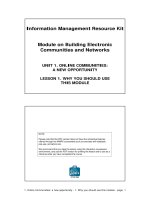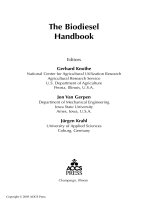Chap020 (full version use this one)
Bạn đang xem bản rút gọn của tài liệu. Xem và tải ngay bản đầy đủ của tài liệu tại đây (3.02 MB, 39 trang )
Chapter 20
Money,
Financial
Institutions,
and the
Federal
Reserve
McGraw-Hill/Irwin
Copyright © 2013 by The McGraw-Hill Companies, Inc. All rights reserved.
Chapter
Twenty
LEARNING GOALS
1. Explain what money is and what makes money
useful.
2. Describe how the Federal Reserve controls the
money supply.
3. Trace the history of banking and the Federal
Reserve System.
4. Classify the various institutions in the U.S. banking
system.
20-2
Chapter
Twenty
LEARNING GOALS
5. Briefly trace the causes of the banking crisis
starting in 2008 and explain how the government
protects your funds during such crises.
6. Describe how technology helps make banking
more efficient.
7. Evaluate the role and importance of international
banking, the World Bank, and the International
Monetary Fund.
20-3
Profile
BEN BERNANKE
Federal Reserve
• Bernanke is a former Princeton economics
professor.
• Former President George W. Bush appointed
Bernanke Chairman of the Federal Reserve in
2006.
• Almost every
factor related to
the economy is
influenced by the
decisions he
makes.
20-4
Chapter
Twenty
NAME that COMPANY
This banklike store in Austin, Texas, was
designed to serve lowincome clients who don’t
have traditional bank accounts. Customers pay
a onetime $10 fee that allows them to cash
checks and put the money onto debit cards.
Name that company!
20-5
What is
Money?
WHAT’S MONEY?
LG1
• Money Anything people generally accept as
payment for goods and services.
• Barter The direct
trading of goods or
services for other goods
or services.
20-6
What is
Money?
LG1
STANDARDS for a
USEFUL FORM of MONEY
• Portability
• Divisibility
• Stability
• Durability
• Uniqueness
20-7
What is the
Money
Supply?
The MONEY SUPPLY
LG2
• Money Supply The amount of money the Federal
Reserve makes available for people. The money
supply is referred to as:
- M1 Money that can be accessed quickly (coins,
paper money, travelers’ checks, etc.).
- M2 M1 + money that may take a little time to
obtain (savings accounts, mutual funds, etc.).
- M3 M2 + big deposits like institutional money
market funds.
20-8
What is the
Money
Supply?
LG2
NEW MONEY
Paper Money Printed in 2010 (In $ Billions)
Source: Bloomberg Businessweek, December 20, 2010.
20-9
What is the
Money
Supply?
LG2
HOW LONG DOES
PAPER MONEY LAST?
Source: Federal Reserve, www.federalreserve.gov, accessed September 2011.
20-10
What is the
Money
Supply?
MONEY MILESTONES
LG2
20-11
What is the
Money
Supply?
LG2
MONEY FACTS
What You Might Not Know About What’s in Your Wallet
• In 2009, the U.S. printed 26,000,000 bills a day!
• Each penny costs 1.6¢ and each nickel costs 6¢
to make.
• The mosttracked bill on WheresGeorge.com has
travelled over 7,600 miles in 4 years!
• 2/3 of all U.S. $100 bills are outside the U.S.
• 90% of paper money has traces of cocaine!
Source: Fast Company, February 2011.
20-12
The Global
Exchange of
Money
LG2
EXCHANGING MONEY GLOBALLY
• Falling dollar value: The amount of goods and
services you can buy with a dollar decreases.
• Rising dollar value: The amount of goods and
services you can buy with a dollar increases.
• What makes the dollar fall or rise is the position
of the U.S. economy relative to other global
economies.
20-13
The Global
Exchange of
Money
LG2
The IMPACT of a
FALLING DOLLAR
• Overseas demand for U.S. products rise.
• A favorable exchange rate for U.S. companies
increases profits in foreign markets.
• U.S. tourism increases
which is good for hotels,
resorts, theme parks,
and retailers that serve
international travelers.
20-14
Basics About
the Federal
Reserve
LG2
FIVE MAJOR PARTS of the
FEDERAL RESERVE SYSTEM
1. The Board of Governors
2. The Federal Open
Market Committee
3. 12 Federal Reserve
Banks
4. 3 Advisory Councils
5. The member banks of
the system
20-15
Basics About
the Federal
Reserve
LG2
The 12 FEDERAL RESERVE
DISTRICT BANKS
20-16
Basics About
the Federal
Reserve
MANAGING the MONEY SUPPLY
LG2
• The Fed uses three basic tools:
1. Reserve Requirement A percentage of
commercial banks’ checking and savings accounts
they must keep in the bank or in noninterestbearing
deposits at the local Federal Reserve district bank.
2. OpenMarket Operations The buying and
selling of government bonds.
3. Discount Rate The interest rate the Fed charges
for loans to member banks.
20-17
The Federal
Reserve’s
Check
Clearing Role
LG2
CHECKCLEARING PROCESS
THROUGH the FEDERAL RESERVE
20-18
Progress
Assessment
PROGRESS ASSESSMENT
• What is money?
• What are the five characteristics of useful money?
• What is the money supply, and why is it important?
• How does the Federal Reserve control the money
supply?
• What are the major functions of the Federal
Reserve? What other functions does it perform?
20-19
The History of
Banking and the
Need for the
Fed
LG3
The ESTABLISHMENT of the
FEDERAL RESERVE SYSTEM
• A cash shortage problem in 1907 led to the
creation of the Federal Reserve System.
• Under the Federal
Reserve Act of 1913,
all federally chartered
banks had to join the
Federal Reserve.
20-20
The History of
Banking and the
Need for the
Fed
LARGEST BANK FAILURES
LG3
Source: , accessed July 2011.
20-21
The U.S.
Banking
System
The U.S. BANKING SYSTEM
LG4
• Commercial banks
• Savings and loan
associations
• Credit unions
• Nonbanks
20-22
Commercial
Banks
COMMERCIAL BANKS
LG4
• Commercial Bank A profitseeking organization
that receives deposits from individuals and
corporations in the form of checking and savings
accounts and uses those funds to make loans.
• A commercial bank has two types of customers:
1. Depositors
2. Borrowers
20-23
Services
Provided by
Commercial
Banks
LG4
COMMERICAL BANKS’
SERVICES
• Demand Deposit The technical name for a
checking account; money is available on demand
from the depositor.
• Time Deposit A savings account; a bank can
require a prior notice before you make a withdrawal.
• Certificate of Deposit A savings account that
earns interest, to be delivered on the certificate’s
maturity date.
20-24
BANKING on SOCIAL MEDIA
(Social Media in Business)
• Banks are using the Internet and social media to
communicate with Gen Y customers.
• Today 29 million Bank of America customers use
online banking.
• 6.5 million customers use smartphones for mobile
banking.
• Banks are following other companies leads and
embracing social media.
20-25









